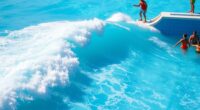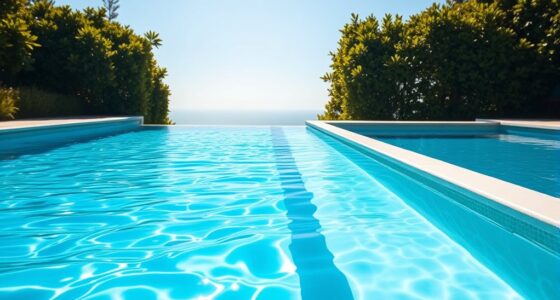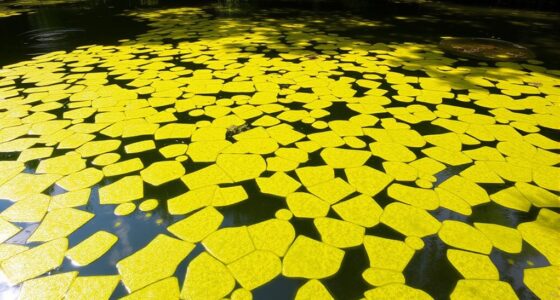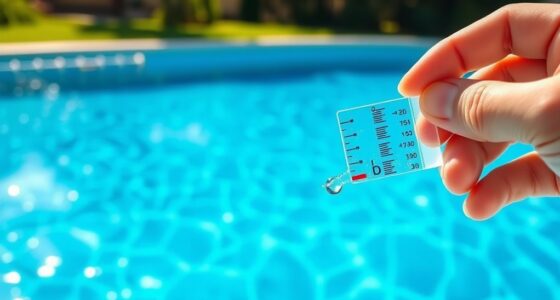To guarantee your DIY backyard splash pad is safe and easy to maintain, choose slip-resistant surfaces like rubber or textured tiles, and design proper drainage with slopes and drains to prevent water pooling. Regularly check water quality by testing chlorine and pH levels, clean filters and nozzles, and keep the area free of debris. Follow safety rules, post signage, and inspect equipment often. Keep your splash pad in top shape with these tips as you continue exploring practical safety and maintenance strategies.
Key Takeaways
- Use slip-resistant, textured surfaces with proper slopes and drainage to ensure safety and prevent water pooling.
- Regularly inspect and maintain drainage and filtration systems to keep water flowing and prevent stagnation.
- Monitor water quality daily, testing chlorine, pH, and microbial indicators to ensure safe, clean water.
- Post clear safety signage with symbols and rules; educate users on proper behavior and supervision.
- Perform routine cleaning, filter maintenance, and equipment checks to keep the splash pad safe and in working condition.
Selecting Safe and Slip-Resistant Surfaces

Choosing the right surface for your backyard splash pad is essential to guarantee safety and fun. You want a surface that stays slip-resistant when wet, reducing the risk of falls and injuries. Non-absorbent materials prevent mold and mildew, keeping the area hygienic. Shock absorption is fundamental, especially for children, to cushion falls and lessen injury severity. Durable surfaces resistant to UV rays and chemicals withstand outdoor conditions and maintain their safety features over time. Textured or embossed surfaces increase traction, further preventing slips. Rubber surfacing is naturally slip-resistant, durable, and easy to maintain, making it a popular choice. Modular interlocking tiles or synthetic turf also provide excellent slip resistance and flexibility in installation. Rubber surfacing is naturally slip-resistant, durable, and easy to maintain, making it a popular choice. Additionally, many of these surfaces are designed for simple cleaning and upkeep, extending their lifespan and ensuring continuous safety. Choosing surfaces with UV resistance can significantly prolong their appearance and safety features, especially in sunny climates. Prioritizing these characteristics helps create a safe, long-lasting splash pad for everyone to enjoy.
Designing for Proper Drainage and Water Flow

To guarantee your splash pad drains efficiently, you need to use effective drainage techniques like sloped surfaces and centralized drains. Proper water circulation keeps the water moving and prevents pooling, which can lead to bacteria growth. By designing with these points in mind, you’ll keep the area safe, clean, and enjoyable for everyone. Traditional trench drain systems have been used historically, but modern slot drain systems offer safer, more hygienic alternatives that are easier to maintain. Incorporating performance cookies can help monitor water flow efficiency and identify potential drainage issues promptly.
Effective Drainage Techniques
How can you guarantee water drains efficiently from your backyard splash pad? Start by designing a slight, consistent slope on the surface, directing water toward drainage points and preventing puddles. Choose durable, non-slip materials like textured tile, rubber, or concrete that resist wear and promote safety. Integrate drainage systems such as trench drains for larger runoff or slot drains for a more discreet, ADA-friendly option, positioned where water tends to accumulate. Incorporate catch basins to trap debris and facilitate maintenance. Make certain your layout distributes multiple drainage points across the pad, reducing pooling. Proper installation of slopes and drainage channels is vital for long-term effectiveness, preventing water stagnation and ensuring smooth water flow. Additionally, understanding essential oils for drainage and circulation can provide insights into optimizing water movement and overall splash pad safety.
Optimal Water Circulation
Ensuring proper water circulation on your splash pad starts with designing a well-graded surface that directs water toward drainage points. You should slope all surfaces at least 1/4 inch per foot, guiding water smoothly to central drains. Avoid flat spots or low areas where water can pool, disrupting flow. Use screeded gravel or sand beds beneath pavers to maintain consistent slope and prevent uneven surfaces. Make sure transitions between different materials don’t create flow barriers, which can trap water and hinder circulation. Proper subgrade preparation is essential: remove sharp debris, stretch the liner tightly, and double up underlayment at corners. Regularly inspect the slope and surface transitions to ensure water moves efficiently, keeping your splash pad safe and functional. Incorporating drainage systems that effectively manage water flow can further enhance circulation and prevent standing water issues.
Preventing Standing Water
Designing effective drainage is essential for preventing standing water on your splash pad. You should incorporate a proper site grading with slopes between 1% and 2%, directing water toward designated drains. Creating a central low point or multiple catch basins ensures efficient water collection and reduces pooling. Use durable, bacteria-resistant materials like stainless steel for drains to prevent corrosion and pathogen buildup. Opt for drainage systems like slot drains, which offer easy cleaning and reduce debris accumulation, or synthetic turf with drainage tiles for quick water flow. Keep edges graded to prevent runoff into surrounding areas, reducing slip hazards and landscape damage. Regularly inspect and maintain your drainage setup, especially after settling or wear, to sustain optimal water flow and safety. Incorporating self-watering system features can also help manage water levels more effectively and reduce excess pooling.
Choosing Appropriate Water Treatment Systems

When selecting a water treatment system, you need to compare disinfection methods to guarantee safe, clean water for your splash pad. Regular water quality testing helps catch issues early and keeps the water safe for everyone. Proper maintenance tips will keep your system running efficiently and extend its lifespan. Additionally, choosing a recirculation system can significantly enhance sustainability by reducing water consumption and providing high-quality water through continuous treatment. Incorporating beneficial ingredients like collagen and hyaluronic acid into your water treatment options can further improve water quality and skin friendliness.
Disinfection Methods Comparison
Choosing the right water treatment system for your splash pad depends on balancing effectiveness, safety, and budget. Chlorination offers broad-spectrum disinfection, residual protection, and cost savings, with options like liquid sodium hypochlorite or solid tablets. It’s ideal for budget-conscious setups but can produce disinfection byproducts like chloramines, requiring management. UV systems inactivate pathogens without chemicals, leaving no residual, but need clear water and proper dosage. Combining UV with chlorine enhances pathogen control, especially against resistant organisms. Advanced oxidation processes provide superior pathogen reduction, including Cryptosporidium, but come with higher costs and complexity. Multi-barrier approaches—like pairing chlorine with UV or AOP—maximize safety, reduce chemical use, and maintain water quality. Implementing secondary disinfection systems can significantly improve water safety, especially in public or high-use splash pads, by providing additional pathogen reduction layers. Visualize:
- Sparkling, clear water
- Chemical-free sterilization
- Cost-effective chlorination
- High-tech UV units
- Sophisticated multi-barrier systems
Water Quality Testing Protocols
Selecting the right water quality testing protocols is vital to maintaining a safe and healthy splash pad environment. You need to regularly monitor key parameters like free chlorine or bromine levels daily to guarantee effective disinfection. Maintaining pH between 7.0 and 7.8 is essential for maximum sanitizer efficiency and preventing corrosion or scaling. You should also routinely screen for microbial indicators such as E. coli, total coliforms, and enterococci to detect fecal contamination. Monitoring turbidity and clarity helps assess filtration performance and swimmer visibility. For detecting resistant pathogens like Cryptosporidium and Legionella, use PCR or culture methods. Employ a combination of testing methods—colorimetric, titrimetric, electrochemical sensors, and lab analysis—to make certain water quality remains safe and compliant at all times. Understanding the history of pinball machines can also inspire innovative designs for splash pad features that blend entertainment with safety.
System Maintenance Tips
Maintaining water quality in splash pads requires not only regular testing but also ensuring that your treatment system functions properly. To keep your system running smoothly, focus on key maintenance tasks.
- Regularly clean and inspect filters to keep water flowing freely and filters effective. Filter maintenance is essential to prevent buildup and ensure optimal filtration performance.
- Check chemical levels (chlorine, pH) and adjust as needed for safety.
- Backwash filters periodically to remove debris and prevent clogs.
- Inspect pumps and valves for leaks or wear, replacing parts promptly.
- Maintain disinfection equipment like UV or ozone systems following manufacturer instructions.
- Modern recirculating systems allow for remote monitoring, which can help detect issues early and ensure consistent water quality.
Ensuring Accessibility and Compliance Standards

Ensuring your backyard splash pad meets accessibility and compliance standards is essential to create a safe, inclusive, and enjoyable environment for all users. You should provide at least a 60-inch wide accessible route with a gentle slope of no more than 1:16 and an 80-inch vertical clearance along pathways, ensuring wheelchair users can move freely. Near the splash pad, include accessible parking, clear pathways, and restrooms with universal features like wide doorways and adjustable fixtures. Incorporate sensory-friendly water features, high-contrast colors, and ample space between components for easy maneuvering. Surfaces must be slip-resistant, meet ASTM standards, and have openings no larger than ½ inch. Designing splash pads to be inclusive and accessible promotes safety, equity, and enjoyment for everyone, regardless of ability. Additionally, regular inspections and maintenance of compliance features ensure ongoing safety and adherence to standards.
Installing Reliable Water Circulation and Filtration Equipment

To keep your splash pad running smoothly, you need reliable pumps that match your system’s size and flow needs. Proper filtration is essential to maintain clean, safe water, so select quality filters suited for your setup. Regular maintenance ensures your system stays efficient and avoids unexpected breakdowns, saving you time and hassle. Investing in high-quality components can also extend the lifespan of your system and improve its overall performance. Additionally, choosing performance upgrades designed for durability can enhance your system’s reliability over time.
Choosing Quality Pumps
Choosing the right pump is essential for reliable water circulation and filtration in your backyard splash pad. Your pump’s flow rate must match your splash pad’s water features to keep effects lively. Make certain it can handle the maximum head height needed for elevated features without losing flow. Opt for energy-efficient models—lower wattage with sufficient flow saves power. The construction material matters: stainless steel or brass offers durability and corrosion resistance, unlike plastic. Confirm the connection size fits your plumbing for seamless installation. Consider pumps with variable speed options for tailored water effects and energy savings. Look for models with quiet operation to prevent noise pollution. A magnetic impeller or adjustable prefilter helps reduce maintenance by preventing debris buildup, extending your pump’s lifespan. Energy-efficient pumps use up to 70% less energy, significantly reducing operating costs over time. Additionally, selecting a pump with advanced filtration technology can further improve water clarity and reduce maintenance needs.
Ensuring Proper Filtration
Installing reliable water circulation and filtration equipment is essential for maintaining clean, safe, and efficient operation of your backyard splash pad. A well-designed closed-loop recirculation system continuously filters and reuses water, reducing waste. Underground storage tanks should match your pad’s flow rate and environmental needs, with auto-fill features to keep water levels steady. Proper piping design minimizes dead legs, ensuring all water passes through the filter. Choose the right filtration type: sand, cartridge, or DE filters, based on your needs, with multi-stage setups for clearer water and less chemical use. Install filters between the pump and distribution manifold, ensuring watertight, corrosion-resistant plumbing. Regularly monitor water chemistry and filter performance to keep your splash pad safe and inviting.
| System Component | Purpose |
|---|---|
| Underground Storage Tank | Stores and recirculates water efficiently. |
| Filter Types | Remove particles and improve clarity. |
| Auto-Fill System | Maintains consistent water levels. |
| Piping Design | Ensures all water passes through filtration. |
Regular System Maintenance
Regular system maintenance is essential for keeping your backyard splash pad safe, efficient, and enjoyable. You need to keep water circulation and filtration equipment in top shape to prevent issues. Visualize pumps humming smoothly, valves adjusting flow seamlessly, and filters catching debris. Regularly check spray nozzles for blockages, flush filters to remove buildup, and run diagnostics to ensure sensors and pressure levels are correct. Seasonal shutdowns require draining and cleaning to prevent damage. Testing chlorine and pH levels maintains water safety, while backflow preventers keep contamination out. Imagine a well-maintained system running smoothly, conserving water, reducing costs, and providing safe fun for everyone. Routine maintenance ensures water quality remains safe for children and families, which is crucial for health and safety standards. Consistent upkeep also involves inspecting water circulation systems regularly to detect potential malfunctions early. This proactive approach ensures your splash pad remains a revitalizing, worry-free feature in your backyard.
Implementing Effective Safety Features and Signage
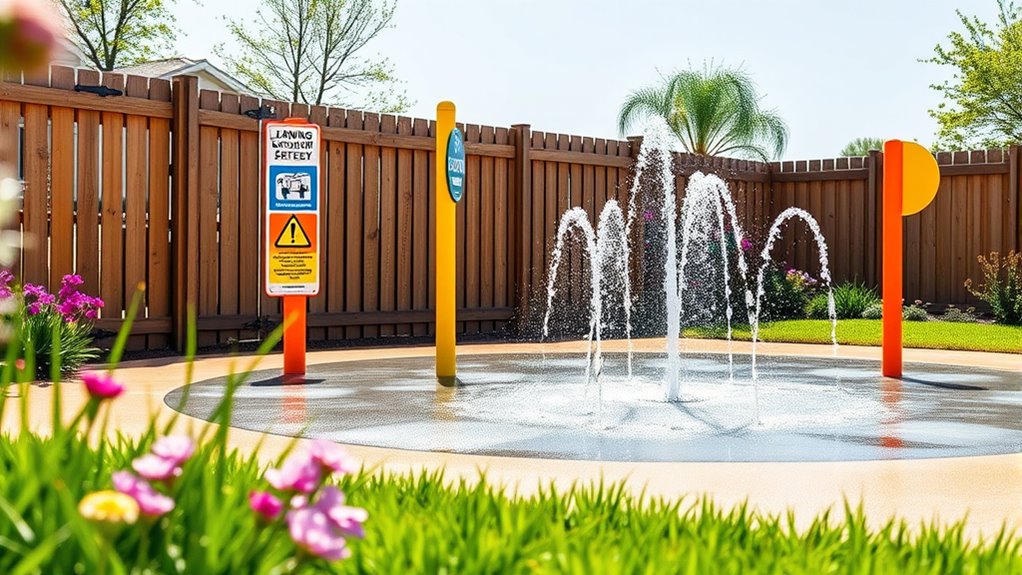
Effective safety features and signage are essential for creating a secure and enjoyable splash pad environment. Clear, visible signs with universal symbols and easy-to-read fonts help users understand rules and hazards, reducing accidents. Place signs at all entrances and throughout the area, warning about slippery surfaces, no running, no climbing, and proper behavior. Include health signs promoting hygiene, like showering beforehand and avoiding swallowing water. Use waterproof, UV-resistant materials to guarantee durability outdoors. Safety surfaces should have a friction coefficient above 0.40, with textured or rubberized materials that stay non-slip when wet. Add visual safety markings and borders to guide foot traffic and highlight hazards. Finally, post emergency contacts, accessible evacuation routes, and supervision requirements to ensure everyone’s safety. Additionally, safety signage and instructions should be regularly reviewed and updated to reflect any changes in regulations or environment, maintaining a consistently safe setting for all users. Incorporating innovative materials from recent trends can further enhance durability and safety.
Regular Cleaning and Surface Maintenance Routines
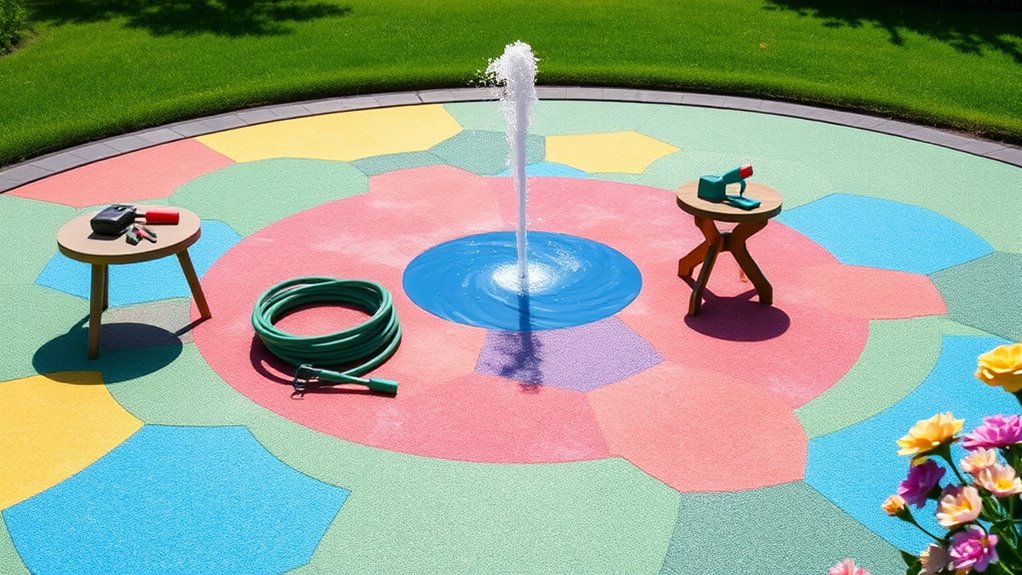
Maintaining a splash pad’s safety and cleanliness requires consistent cleaning routines and surface upkeep. Regularly removing debris like leaves, sticks, and trash keeps the area clear and prevents clogs. Inspect surfaces for standing water and promptly eliminate it to reduce slip hazards. Check and clean spray nozzles and activators to ensure water flows freely. Sweeping the surface regularly prevents dirt and organic buildup, while rinsing with water minimizes algae and grime. Incorporating surface hygiene practices helps maintain a safe and enjoyable environment.
Monitoring Water Quality and Sanitation Practices

To guarantee a splash pad remains safe and hygienic, you need to actively monitor water quality through frequent testing and diligent record-keeping. Test chlorine or bromine levels and pH before daily use, and check every 2–4 hours during operation to ensure safety and regulatory compliance. Keep pH between 7.0 and 7.8 for effective disinfection and user comfort; improper pH reduces sanitizer effectiveness and can cause skin irritation. Verify disinfection system performance daily, and consider secondary methods like UV for extra protection. Maintain detailed logs of test results, disinfection procedures, and maintenance activities to support compliance and troubleshooting. Use potable water sources and regularly test backflow preventers to prevent contamination, ensuring your splash pad stays clean and safe for everyone. Proper filter maintenance and regular cleaning are essential for maintaining effective sanitation and preventing pathogen buildup.
Educating Users on Splash Pad Rules and Safety

Clear communication of splash pad rules is essential for ensuring everyone’s safety and enjoyment. You should post clear signs at all entrances and throughout the area, using simple language and pictograms to help kids understand. Reinforce rules verbally, especially for first-time visitors or children unfamiliar with safety etiquette. Regularly update signage to reflect current health guidelines. To promote hygiene, remind users to shower before entering, avoid splash pad use when sick, and practice hand hygiene. Lack of regulation can lead to inconsistent disinfection practices, so emphasizing proper hygiene measures is crucial. Enforce behavior with adult supervision, prohibit running and rough play, and recommend water shoes for traction. Encourage respectful play, discourage tampering with features, and teach children to listen to supervisors. Educating users helps prevent accidents, promotes health, and keeps the splash pad safe and fun for everyone. Additionally, understanding the health benefits of fruit juice varieties can motivate families to incorporate healthier drinks into their routines, supporting overall wellness.
Performing Routine Inspections and Troubleshooting
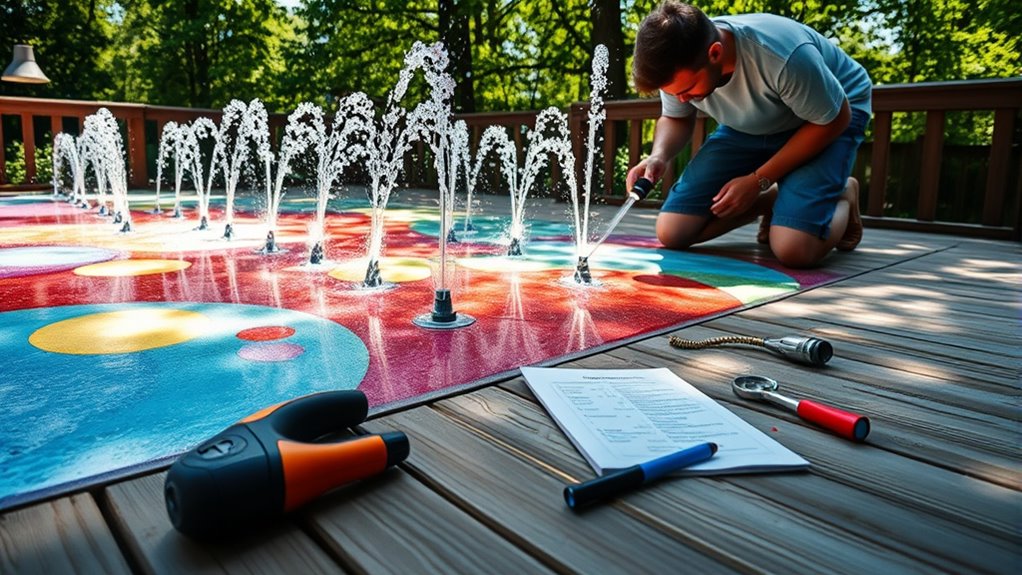
How can you guarantee your splash pad operates safely and efficiently? Regular inspections are key. Test chlorine and pH levels every 2-4 hours, keeping pH between 7.0 and 7.8. Visually check spray nozzles, drains, and activators for blockages or damage. Remove debris like leaves and sticks, and ensure surfaces are slip-free. Confirm that disinfection and filtration systems work properly. Weekly, inspect filters, run diagnostics, and look for wear or vandalism. Check nozzles for clogs, mineral buildup, or damage, cleaning or replacing as needed. Troubleshoot issues like low pressure, water clarity, or leaks by inspecting filters, nozzles, and connections. Proper routine checks prevent problems and maintain safe, smooth operation. Regularly verify system functionality to identify potential issues early and ensure continuous safe operation.
Frequently Asked Questions
How Can I Prevent Algae Growth in My Backyard Splash Pad?
To prevent algae growth in your backyard splash pad, limit nutrient input by avoiding over-fertilizing nearby plants and removing debris promptly. Increase water movement with a pump or fountain to keep water circulating and discourage algae. Provide shade using umbrellas or aquatic plants like water lilies to reduce sunlight exposure. Regularly clean the pad with gentle, algae-fighting solutions like vinegar-water mixtures, and guarantee proper filtration to maintain clear, healthy water.
What Are the Best Ways to Secure Outdoor Electrical Connections for Safety?
To secure outdoor electrical connections safely, you should always use weatherproof, UL-listed outlets and covers, guaranteeing they’re properly sealed and childproof. Test GFCI outlets regularly to confirm they work correctly, and keep all wiring protected with approved conduit or protective enclosures. Keep cords off the ground, away from water, and avoid overloading circuits. Regular inspections and hiring licensed electricians for installation and maintenance are essential to minimize risks and ensure safety.
How Often Should Water Filters and Pumps Be Serviced?
You should service your water filters every 1-2 weeks during peak use, rinsing cartridge filters and backwashing sand filters when pressure rises or debris accumulates. Pumps need inspection every 1-2 weeks for clogs, debris, and unusual noises. Regularly wipe down pump surfaces and perform monthly system diagnostics. Replace cartridge filters every 1-2 years, sand every 5-7 years, and inspect DE grids annually to keep your system running smoothly.
Are There Environmentally Friendly Disinfectants Suitable for DIY Splash Pads?
Yes, you can definitely use environmentally friendly disinfectants for your DIY splash pad. Hypochlorous acid solutions, stabilized aqueous ozone, and UV light sanitizers are incredibly effective, safe for skin contact, and leave no harmful residues. These options are eco-friendly, biodegradable, and often meet regulatory standards. Using them guarantees your splash pad stays clean without risking your family’s health or harming the environment, making your project both safe and sustainable.
How Do I Ensure My Splash Pad Is Accessible for Children With Disabilities?
To make your splash pad accessible for children with disabilities, you should include ADA-compliant parking and smooth, wide pathways with ramps. Add ground-level water features, barrier-free entry points, and transfer stations for easy mobility. Incorporate sensory-friendly elements like gentle mists and textured toys, and use clear signage with contrasting colors. Guarantee slip-resistant flooring, shaded resting spots, and open sight lines so caregivers can easily supervise, creating an inclusive, safe environment for all children.
Conclusion
Creating a DIY backyard splash pad offers endless fun, but safety and maintenance are your top priorities. Think of it as balancing a delicate dance—pairing playful water features with slip-resistant surfaces and vigilant upkeep. While the sun shines and laughter echoes, remember that regular cleaning and inspections keep your splash pad safe and sparkling. With careful attention, your backyard oasis becomes a place where joy and security flow together seamlessly.


